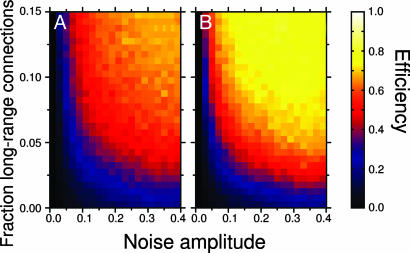Fig. 6.
Density classification for a scale-free network topology. (A) If only the distribution of outgoing links decays as a power law, some of the units, the ones with more outgoing connections, cast a global influence on the system while accessing only local information. These units act as “blind” leaders, determining the evolution of the system without querying the state of the majority of the units. In this case, the scale-free topology decreases the efficiency of the majority rule. (B) A different picture emerges if the longrange connections are bidirectional. Then, the units that influence a large number of other units also access a large amount of information. In this case, the system is able to reach consensus and attains an efficiency of 0.8.

